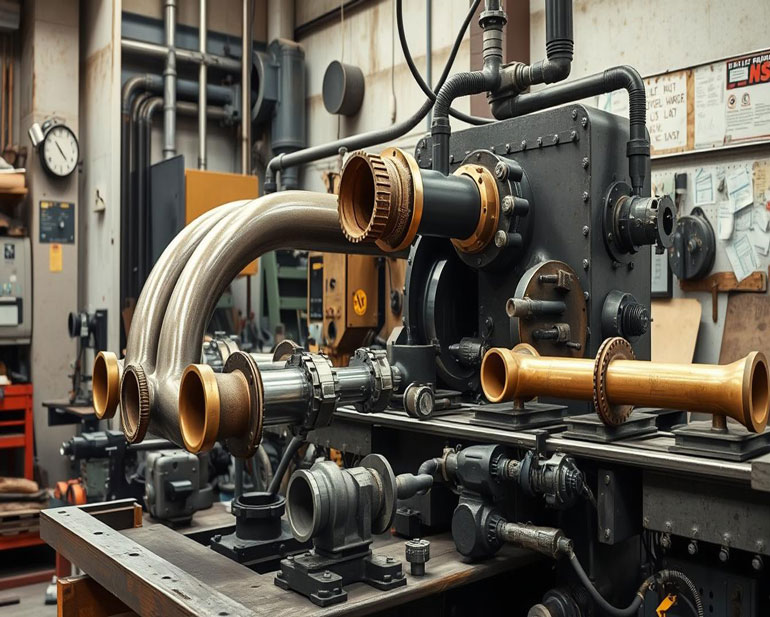Welcome to Mingzheng Precision Machinery
CNC Tube Bending Machine Guide: Definition, How It Works, Features, Types, Composition, Applications
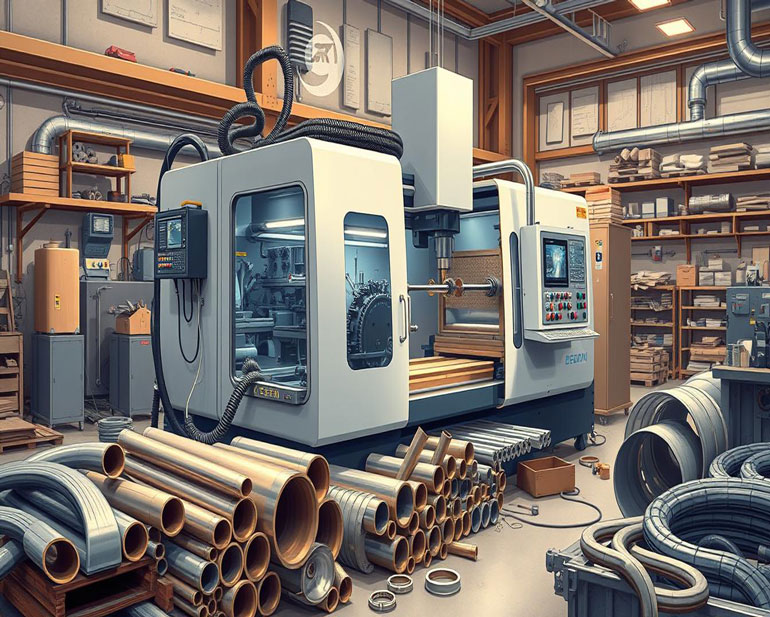
14 Apr
CNC Tube Bending Machine Guide: Definition, How It Works, Features, Types, Composition, Applications
Explore the essentials of tube bending with our CNC Tube Bending Machine Guide—covering types, features, and uses for precise metal forming.
CNC Tube Bending Machine Guide: Definition, How It Works, Features, Types, Composition, Applications
Have you wondered how cars and airplanes get their parts to bend just right? It's all thanks to CNC tube bending machines. These machines are key, yet often not talked about much. They make industries like automotive and aerospace shape metal perfectly1. They switch from hand-made to automated, giving exact, repeatable, and safe results12.
Looking closer at these machines shows they work well with many materials. They even handle tricky ones like aluminum without breaking it12. They come with safety features and adaptability, keeping operators safe while making parts consistently1. This guide will cover how these CNC benders do their magic to make complex parts and why they are so important in making metal things1.
These machines blend power from hydraulic or servo drive systems for detailed bends. The accuracy of servo systems boosts how much they can make1. We'll show how these advanced machines fit many uses and how their do-it-all skills are crucial for fast, quality manufacturing today1.
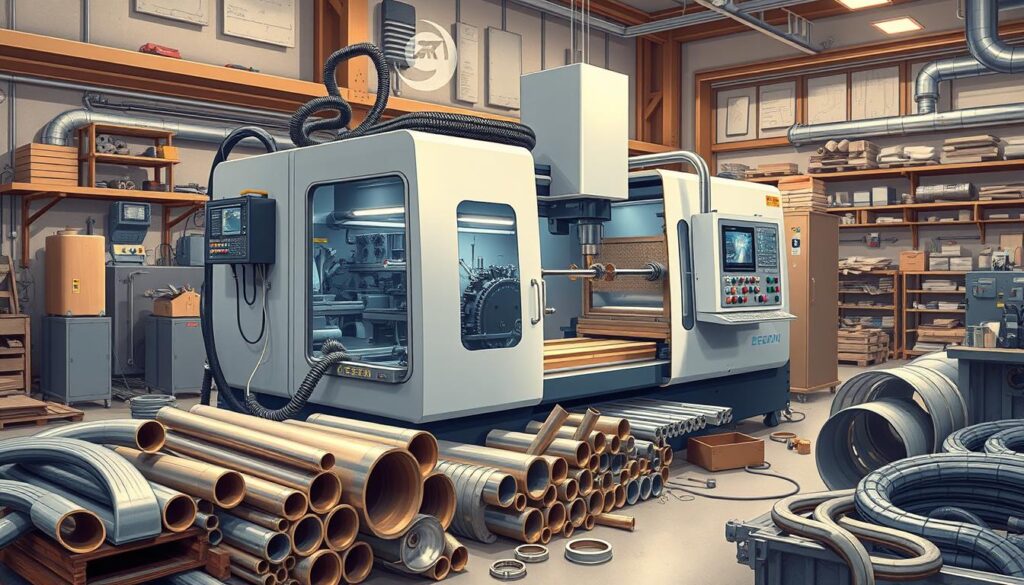
Understanding CNC Tube Bending Technology
CNC tube bending technology marks a big change from old methods to new, automated ones. This change helped do things faster and with more accuracy in shaping metal. It's not just an upgrade in tech but also a big step forward in how things are made.
The Evolution of Tube Bending: From Manual to CNC
The move from hand-operated tube benders to advanced CNC machines is a huge leap. CNC stands at the heart of this shift, cutting down on manual work, upping accuracy, and making the bending process smoother by controlling many parts at once3. These improvements have made CNC tech vital for precise and efficient work.
How Computer Numerical Control Transforms Bending Precision
Electric CNC benders, the latest in this tech, are not just highly accurate but also save energy. This means they cost less to run over time because they need less fixing. This switch makes workspaces cleaner, quieter, and greener3. With total control over bending, every curve is as perfect as needed, which is super important in some fields.
Key Features of Modern CNC Tube Bending Machines
Current CNC tube benders can work with tubes up to 42mm wide and 2000mm long. They fit many needs, from making fuel pumps to playground gear4. These machines keep pipes strong, which is good for lots of uses, like in traffic signs and exhaust systems4. They can also make different pipe shapes, so customers get what they want, making CNC benders more versatile.
Using modern CNC technology in making things meets the need for better quality. It also makes creating pipes and tubes safer and more durable, which is key for them to last long4. As needs grow and change, CNC tube benders are more important than ever for top-notch tube bending and picking the right machine for the job.
CNC Tube Bending Machine Guide: Operating Principles
To grasp CNC tube bending machines, we begin with precision. These machines follow a system controlled by advanced software. This ensures each bend is right down to the tiny details.
First, operators feed complex programming into the machine's control system. This programming tells the machine everything. From bending angles, sequences to tool choices, all are set to meet the project's needs. The operator sets the workpiece, picks the right tools, and begins bending. A ram, powered by hydraulics or servos, presses the tube into shape5.
CNC tube bending machines make bends better and last longer. They keep tools working well and improve how the process is controlled. This is through things like pressure-die assist and exact mandrel placement.
These machines use multi-axis CNC systems. They can bend in many ways, making complex shapes. This is important in car making and flying machine fields6.
Unlike old systems, CNC reduces needing people's hands. It brings down mistakes and makes production more efficient. Swapping tools and handling materials without humans makes things faster. It does this without losing quality6.
These machines think about the environment, too. They use electric motors instead of hydraulic ones. This means they use less power and cost less to run7. Plus, with fewer parts that move, they don't need as much care. This reduces not just downtime but costs over time7.
The advanced control in CNC tube bending machines is a big step up. They offer precise control over bending. This is key to making top-quality products7.
| Feature | Benefit |
| Automated Tool Changes | Minimizes downtime, improving production efficiency. |
| Multi-Axis CNC Control | Allows for intricate bends in multiple planes, enabling complex designs6. |
| Electric Servo Motors | Reduce operational costs and environmental impact7. |
| Real-Time Monitoring | Ensures consistent quality and control during production6. |
| Less Maintenance | Lower lifecycle costs due to fewer mechanical parts7. |
Using CNC in tube bending boosts production, making operations more adaptable and efficient. This is vital for staying ahead in today's quick market.
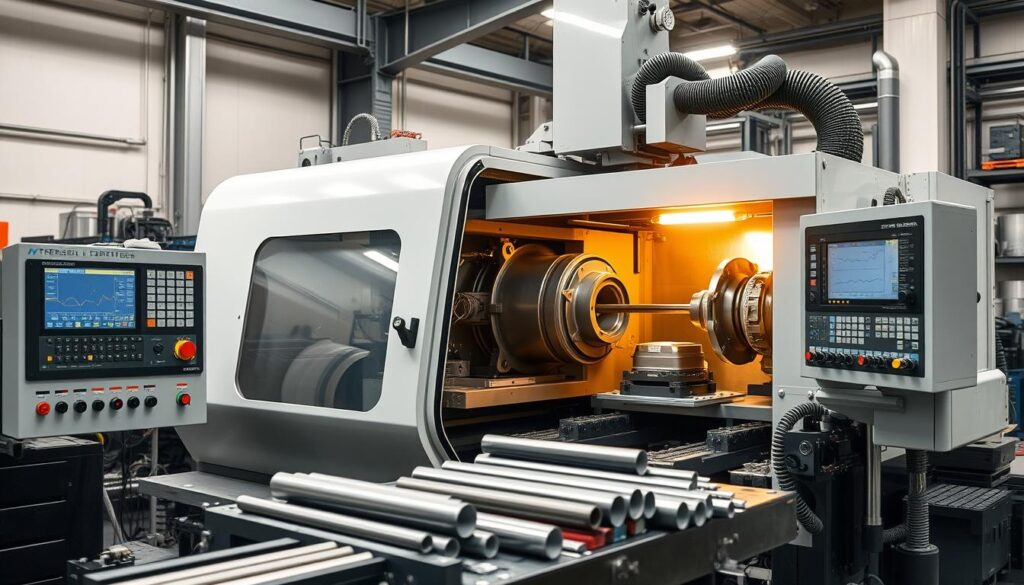
Types and Components of CNC Tube Benders
CNC tube bending machines are known for their efficiency and accuracy. When you understand the types of CNC tube benders and their parts, choosing becomes easier.
Comparing Hydraulic and Servo-Electric CNC Benders
Hydraulic CNC benders use fluid power for heavy-duty bending. Meanwhile, servo-electric CNC benders use electric motors for better control and accuracy89. Your needs and application details help decide which one is right for you.
● Hybrid CNC benders combine electric and hydraulic controls for precise movements8.
● All-electric CNC benders, like the FlectePro 259AEMI, offer precision and are cost-effective. They have up to nine servo axes8.
In a CNC tube bending machine comparison, look at operating costs, maintenance, and the quality of work.
Essential Parts of a CNC Tube Bending Machine
A modern CNC tube bender has key parts that make it work well:
● Control System: This computer interface lets you make precise adjustments during bending.
● Bending Assembly: This includes the ram, die, and punch that shape the tube.
● Backgauge: It's crucial for placing the workpiece right8.
● Safety Measures: Each machine has special safety features to protect the user.
Every part, from the bend die to the mandrel, is important. They help prevent tube collapse or keep the tube in place during bending9.
Understanding Multi-Axis Bending Capabilities
Multi-axis CNC benders are great for complex bends. They often have at least three servo-controlled axes. These are for bending, feeding, and rotating8.
This advanced control means better consistency and less waste. So, the multi-axis CNC tube bender is ideal for industries that need complex shapes and precise tolerances.
To learn more about CNC tube benders, check out this detailed overview.
Selecting the Right CNC Tube Bending Machine for Your Application
Choosing the right CNC tube bender is key for precise and efficient tube bending. With many models out there, knowing which CNC tube bender fits your needs is crucial for your work. It greatly affects your production results.
Deciphering the Features for Your Industry Needs
Different industries, like automotive and aerospace, need specific tube bending specs. For example, aerospace businesses often go for all-electric machines for their accuracy and energy saving.
Given the wide range of materials used, from soft aluminum to strong titanium alloys, the machine must match the job. All-electric models are known for their good performance with various thicknesses and tube sizes10.
Tube Bending Machine Comparison: Finding the Best Fit
Comparing top CNC tube bending machines helps find the right one. The BLM GROUP Elect series and AKYAPAK ABM models are worth looking into. The AKYAPAK ABM 38 CNC works well for small operations with its ability to handle up to 38 mm tube diameter11.
For bigger operations focusing on high volume and efficiency, the ABM 50 CNC is better with its 50 mm tube diameter capacity11. Also, think about total ownership costs, including upkeep and potential downtime, and how they impact your budget and work flow11.
Critical Considerations for Material and Thickness
The material and thickness of your tubes greatly affect which machine to choose. Bending hard steels or titanium requires a powerful machine that won't harm the tube. This points to strong hydraulic tube benders10.
Softer materials like copper and aluminum allow more machine options. They're easier to bend without causing damage10. Therefore, make sure the machine's specs match the material properties to avoid issues like tearing10.
Talking to experts, such as those from BLM GROUP, can greatly help in making a wise choice10.
In conclusion, knowing your industry's needs and comparing machines carefully is vital. This ensures your investment supports not just today's tasks but also future projects. With the right balance, you'll find the best CNC tube bending solution, boosting your production and quality.
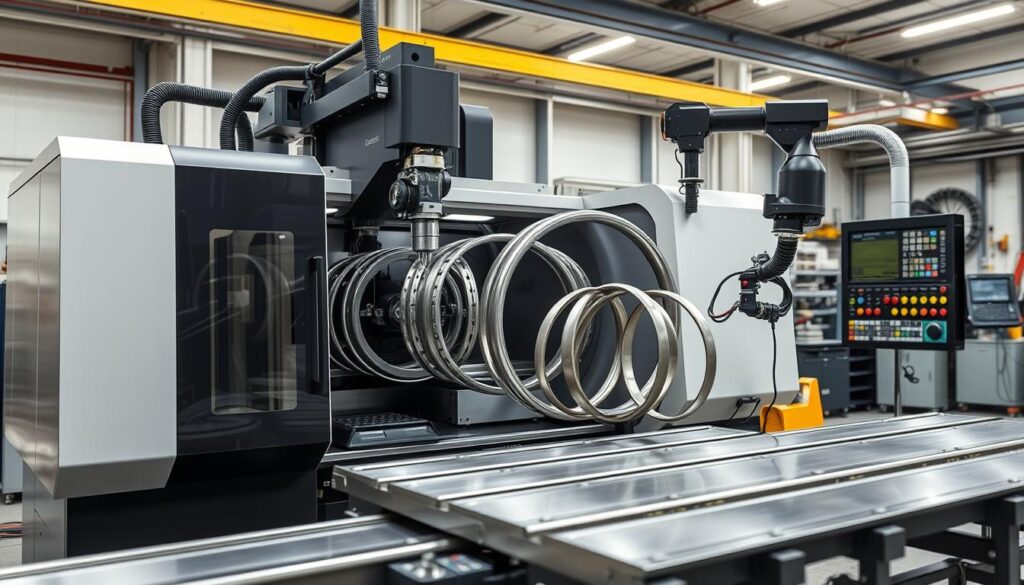
Conclusion
For those in the manufacturing field, knowing all about the CNC Tube Bending Machine Guide is key. In the metalworking world today, CNC machines beat manual ones. They bring better accuracy, more efficiency, and full automation12. By understanding different CNC processes like press and rotary draw bending, we see how they shape metals. This includes aluminum and steel12.
Many industries gain from these machines, from cars to space and healthcare devices13. Sticking to top tube bending methods means quality and accuracy stay top-notch13. With new tools and tech, like software for planning and lasers for measuring, the future points to more innovations and better operation13.
We aim to give our clients the best quality and newest knowledge to help them choose the right CNC tube bender. Looking forward, we share tips and insights on tube bending machines. This shows our dedication to making our customers happy and improving manufacturing. Using CNC bending meets the need for big orders without sacrificing quality. It's perfect for the many shapes and jobs industries need today1213.
FAQ
What is a CNC tube bending machine?
A CNC tube bending machine bends tubes and pipes precisely. It uses computer control. This is key in industries like automotive and aerospace. These areas need exact metal shapes. Thus, it boosts productivity and is more reliable than bending by hand.
How does a CNC tube bender work?
CNC tube benders use computer systems to control bending. They have a ram and die/punch setup. This system can bend material accurately. You can set exact angles and sequences. It uses hydraulic or servo systems for force. So, it creates perfect bends for complex shapes.
What features should I look for in a modern CNC tube bending machine?
Look for a CNC tube bender with multi-axis bending. It should have an easy interface and precise controls. Also, check for various tooling options. This lets it handle different bends and materials. Efficiency is important, too. It should do many bends at once.
How do I choose the right CNC tube bending machine for my application?
First, think about what you need for your work. Check the bending capacities and control system. Also, look at tooling options and material handling. Then, compare models by their force, precision, and flexibility. Choose what fits your production needs best.
What are the differences between hydraulic and servo-electric CNC benders?
Hydraulic CNC benders use fluid for force. They're good for tough jobs. Servo-electric benders use electric motors. They're precise and use less energy. These are better for detailed tasks with less force.
Why is multi-axis bending important in CNC tube bending machines?
Multi-axis bending lets you create complex shapes. CNC machines with this can work on many planes at once. This means more intricate designs. It also means more work is done faster and with less setup time. It's vital for advanced manufacturing.
Can CNC tube bending machines handle different materials and thicknesses?
Yes, they can bend various materials like steel and aluminum. The machine's power and the tools used determine the thickness they can handle. Matching the machine to the material and thickness is critical. It ensures the material keeps its shape and achieves the right bend.

